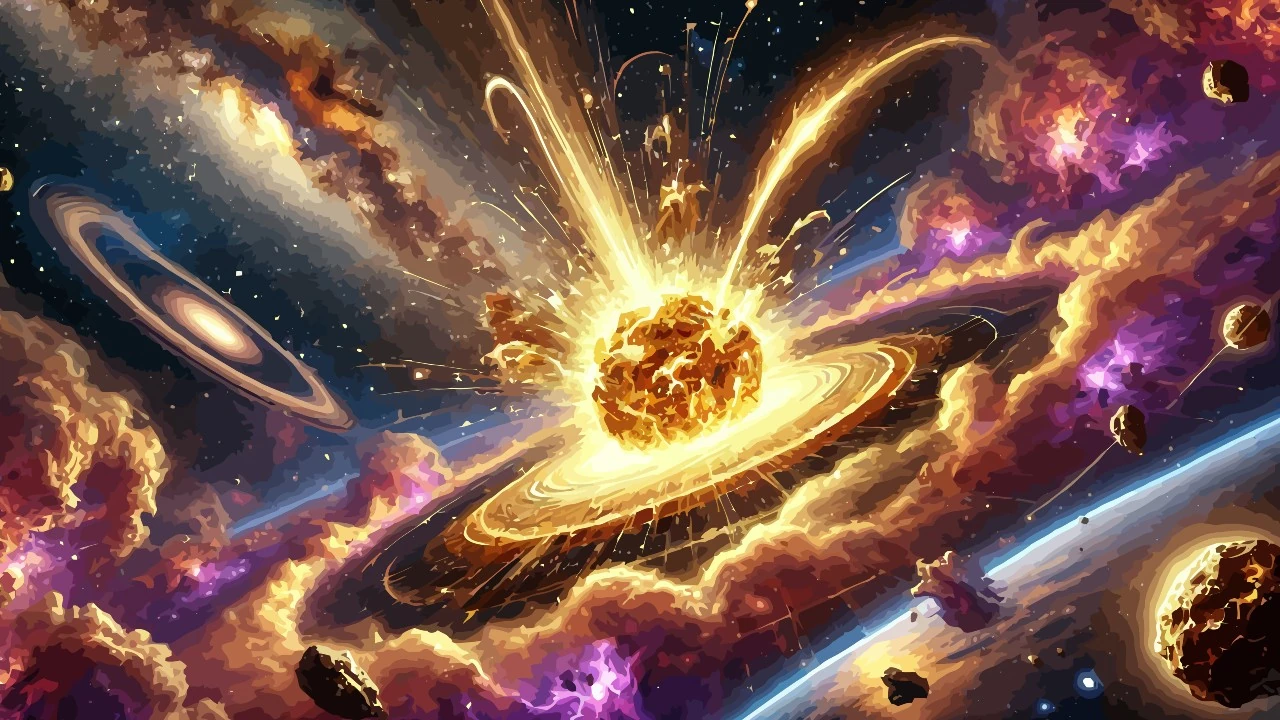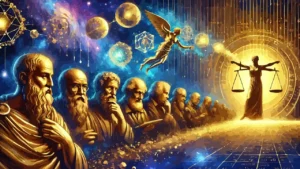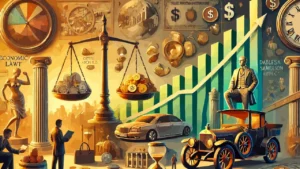Gold is one of the most fascinating elements in the Universe, formed under extreme conditions and distributed throughout the cosmos by catastrophic events. Its presence on Earth is the result of astronomical processes that began billions of years ago.
This precious metal has traveled through space to end up embedded in the Earth’s crust, becoming over time a symbol of wealth and power. Its rarity and unique properties have made it a coveted commodity in many civilizations. In this article, we will analyze the formation of gold, its distribution in the Universe, and the cost of its artificial production.
Contents
#1. The cosmic origin of gold
Gold does not form spontaneously on Earth: its origins are rooted in catastrophic cosmic events . Gold atoms are created through a process called heavy element nucleosynthesis, which occurs under extreme pressure and temperature.
For millennia, scientists have wondered where this rare metal comes from, until recent studies have confirmed that the main source of gold production is neutron star collisions. When two neutron stars collide, nuclear reactions occur that are so powerful that they generate a wide range of heavy elements, including gold. The event causes a gigantic explosion of material that spreads into space, enriching future nebulae and forming solar systems.
In addition to neutron star mergers, supernovae can also generate gold, although in smaller quantities. When a massive star reaches the end of its life and explodes, the elements in its core are blasted out into space, helping to create the materials that make up today’s planets.
Instead, the widespread and erroneous narrative that gold was formed during the Big Bang is not supported. In fact, only the lightest matter was formed during that event.
#2. The formation of gold on Earth
The formation of the Earth and the Solar System began from a gigantic primordial nebula of gas and dust, rich in elements created by the end of previous generations of stars. This nebula, under the effect of gravity, began to collapse on itself forming the protoplanetary disk around what would become our star, the Sun.
Within the protoplanetary disk, heavier materials, such as iron, nickel, and gold, began to coalesce (increase in size) under the action of gravity, forming small grains of dust and then larger bodies, called planetesimals. These planetesimals continued to collide with each other, aggregating to form protoplanets, including Earth.
During this phase, huge amounts of materials from space were incorporated into our forming planet. Gold, being a heavy element, tended to migrate toward the Earth’s core, along with other metals such as iron and platinum. However, subsequent impacts of asteroids rich in precious metals helped to redistribute some of these elements in the Earth’s crust and mantle, making them accessible in gold-bearing rocks and river deposits.
The Late Great Bombardment, which occurred about 4 billion years ago, further enriched the Earth’s crust with materials from space, helping to form some of the oldest gold deposits on the planet. Volcanic events and the movement of tectonic plates then transported and concentrated the gold in certain areas, giving rise to the gold deposits exploited by man.
The gold we find on the Earth’s surface today is therefore the result of billions of years of geological and cosmic processes, a gift from the stars that traveled through space to end up in our rivers and mountains.
#3. The amount of gold in the universe
Gold on Earth is not evenly distributed, and its total quantity is difficult to estimate. It is estimated that there are about 1.6 quadrillion tons of gold in the Earth’s core, but the vast majority of it is inaccessible. In the Earth’s crust, however, it is estimated that there are about 50,000 tons of gold still extractable, while almost 200,000 tons have already been extracted throughout history. An average of 3,000 tons of gold are mined each year , with global production set to decline in the coming decades due to the depletion of deposits.
If we look at the Solar System, we find that some asteroids contain enormous quantities of gold and other precious metals. One example is 16 Psyche , an asteroid composed mostly of metals, which could contain trillions of tons of gold. However, mining this gold is currently impractical due to the prohibitive costs of space missions.
In the Milky Way, scientists estimate that the total gold could amount to 1 billion billion tons, scattered among stars, dust, and planets. At the cosmic level, gold exists in untold quantities, with neutron star mergers and supernovae continually producing it and spreading it throughout the Universe.
Although gold exists in abundance in space, the main problem is its dispersion: collecting and using it is a technologically and economically prohibitive undertaking. For this reason it is rare and the Earth remains the main source of extraction accessible to man.
#4. Artificial gold and its impossible cost
Creating gold artificially is possible, but it is currently an extremely expensive and inefficient process . To obtain just one gram of synthetic gold using a particle accelerator, it is necessary to bombard mercury or bismuth atoms with neutrons or protons at very high energies. This process requires enormous amounts of energy and advanced machinery.
By some estimates, the cost of producing a single gram of gold with a particle accelerator could range from $50 billion to $100 billion, making it economically impractical compared to traditional mining. Furthermore, the time required to transform light atoms into gold is extremely long, often requiring days or weeks of continuous nuclear bombardment.
Another technical difficulty is the instability of artificially produced isotopes: synthetic gold obtained from nuclear reactions often contains radioactive isotopes with variable decay times, making it unsuitable for immediate commercial uses.







Leave a Reply